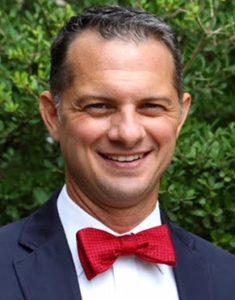Mark Wingfield makes a compelling case that “You cannot follow Jesus and endorse racism.” However, he may have placed the “Period” of his title a little too soon.
I do believe the biggest problem in perpetuating racism is the “virulent white supremacist views” of people of faith, but I believe that virus is far more widespread than most of us white progressive Christians care to admit.

Jon Singletary
Let me be clear in my agreement with Wingfield. As he says, “The Jesus of the Gospels allows no room for being a racist or enabling racism. White supremacy and racism are wholly incompatible with a Jesus way of life.” And, Donald Trump’s white supremacy does contribute significantly to empowering hate groups and sustaining our culture of racism.
However, too few white Christians in our churches, families and places of employment see themselves as racists, or even as people who do racist things, or benefit from racist things that are happening all around them. I certainly would say that I am not a racist, but I know I continue to benefit from racist systems and as a result I do racist things, even if I cannot see my acts as such.
I assume most Christians are non-racists, and they would also denounce white supremacy even as the president attempted to do by the end of the week. Yet, the power of whiteness and white supremacy culture runs on autopilot while all of us good white people stand by declaring ourselves not racist. That’s all it takes to allow our churches, families and places of employment to maintain our white privilege and continue to marginalize and harm Black, Indigenous and people of color.
One of the things I learned years ago in social work education is that race (including whiteness) is human made, what we call a “social construct.” Black and white as racial categories are not biologically real; most of us know that today. So how did the constructs come about?
For economic security and growth at the birth of our nation, white colonialists created race through economic policy, primarily chattel slavery, and the denial of citizenship to those who are Black, Indigenous or persons of color. As a result, and perhaps more importantly, this led our forefathers to create racism. Their need to control wealth — their need to control other people in order to control wealth — is what resulted in the creation of race.
“Race is the child of racism, not the father.”
Racism is the hunger for power based on a sense of moral, political and economic superiority that created race. Racism is not individual acts of prejudice and discrimination; it is the deeply imbedded political, economic, educational and religious systems and structures that perpetuate our power and privilege as white people. As Ta-Nehisi Coates writes, “Race is the child of racism, not the father.”
Creating and sustaining race and racist systems have been the primary acts of white supremacy in our American history. All it takes now to perpetuate the systems of racism and culture of white supremacy is for all of us good white Christian people to continue living as non-racists. Our ongoing system of racialized exploitation, oppression and marginalization runs on its own. Only acts of explicit antiracism can undo the damage we have done.
This phenomenon is what Beverly Daniel Tatum describes as the moving walkway of racism. Moving walkways that move us forward, like those at some airports, provide an analogy for how racism works in America. Racism continues to move forward in society, and the vast majority of Americans know it is wrong, so we make choices that are non-racist. That’s like not walking on a moving walkway; you are still moving forward on the system. The only decision that works is to stop, turn around, and actively walk in the other direction. She describes this as the work of antiracism.
“The only decision that works is to stop, turn around, and actively walk in the other direction. This is the work of antiracism.”
It is difficult for us to make sense of this still, given the entrenched belief we have that racism and even white supremacy are about individual beliefs, actions or attitudes rather than systems. We are so individualistic in our white culture that understanding something this systemic is a challenge for us.
How can we learn to turn around and walk against these systems?
First, we have to learn to see the nature of the system. Do we recognize the unearned privilege and advantage we have compared to colleagues of color? The ways we make decisions that often exclude people of color? On behalf of them? That we assume we support them? Without asking them? The positions we hold that have been denied them? The power we hold that is not extended to create equity or inclusion?
People of faith, we have work to do. We must begin by joining Wingfield in denouncing white supremacy, particularly in Christian organizations. We must speak out against individual acts of racism where they do exist. And, more importantly, we must continue to learn about the complex, systemic nature of racism that is deeply imbedded in most of the structures where we live and serve on a daily basis. These are the entities that we have to learn to turn around.
Antiracism is the work of all white people, including those of us who have tried to be the good ones.
In the end, Wingfield is right, “as Jesus said about another matter, ‘You cannot serve two masters.’” The master of white supremacy just holds a tighter grip on most of us than we care to recognize.
Are we willing to do the harder work of turning around in this crowd to walk against it? It’s not just your neighbor with the Trump sign who has brought us to this point. Even with that Biden sign, can you see the ways you are devoted to the master that is whiteness in your life?
Jon E. Singletary serves as dean of the Garland School of Social Work at Baylor University and holds the Diana R. Garland Endowed Chair of Child and Family Studies.
Related articles:


